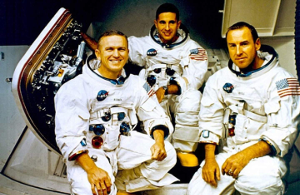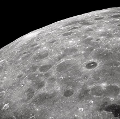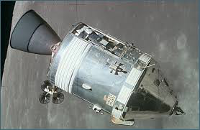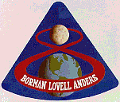Apollo 8: First Lunar Orbit
Apollo 8 was the first manned mission to leave Earth's atmosphere and to orbit the Moon. Apollo 8 launched on Dec. 21, 1968. It was the third launch of the Saturn V rocket, the next generation following the Saturn I-B, which had been used for Apollo 1 and Apollo 7. The Saturn rocket had been tested only twice before: The first test was successful, and the second test was plagued by technical glitches. The third launch went off without a hitch. It was the first manned spacecraft to leave Earth's gravity and the first to reach the Moon. Original mission plans were to achieve only the former; however, after hearing that a Soviet spacecraft, Zond 5, had circled the Moon with animals aboard and returned them safely to Earth, Apollo officials added the lunar orbit to the Apollo 8 program. 
The Command Service Module in which the crew of Commander Frank Borman (left, left), Command Module Pilot Jim Lovell (left, right), and Lunar Module Pilot William Anders (left, center) traveled was essentially the same as the one used on Apollo 7, with the exception of a new combined forward hatch, the primary function of which would be, on future missions, to allow astronauts to transfer to the Lunar Module. Among their primary tasks was to test the firing systems once they had achieved lunar orbit, simulating what an eventual lunar landing mission would do. They also tested the limits of communication and tracking systems. The Moon is more than 252,000 miles from Earth, and scientists did not know for sure whether they would be able to communicate or even track the spacecraft for that kind of distance. They were also to facilitate six live TV transmissions during the course of the mission. 
Apollo 8 arrived at the Moon in three days and set about taking photographs of the lunar surface, both on the near side and on the far side, again in preparation for a lunar landing. 
Because the crew were orbiting the Moon on Christmas Eve, they were inspired to use one of their TV transmissions to read from the Biblical book of Genesis the story of Creation. All three astronauts took turns reading from the Bible, their words traveling through space and to listeners back on Earth. When it was time to return, Apollo 8 went one last time behind the Moon for a final burn, to power the return flight. Whenever the spacecraft went behind the far side of the Moon, their signal The mission was not without incident. Mission commander Borman was sick with both vomiting and diarrhea, and the entire crew struggled with random things floating in the zero-gravity close quarters of the spacecraft. He recovered quickly. The spacecraft returned to Earth six days later, splashing down in the Pacific Ocean on December 27. They had completed 10 lunar orbits, taken photos of both the Earth and the surface of the Moon, tested several critical systems, and survived the return trip to Earth. Other notes:
|
|
Social Studies for Kids
copyright 2002–2025
David White



 Along the way, they deviated from mission specifications slightly to snap one of the most photographs in human history, Earthrise. Anders was behind the camera, and his iconic shot of the parent planet was eclipsed only by what the crew did next.
Along the way, they deviated from mission specifications slightly to snap one of the most photographs in human history, Earthrise. Anders was behind the camera, and his iconic shot of the parent planet was eclipsed only by what the crew did next. was lost and everyone on Earth held their breath. One of the first things that Lovell said to Mission Control when they had re-established contact was, "Please be informed, there is a Santa Claus." (This was not the first time that an astronaut had mentioned the iconic Christmas figure.
was lost and everyone on Earth held their breath. One of the first things that Lovell said to Mission Control when they had re-established contact was, "Please be informed, there is a Santa Claus." (This was not the first time that an astronaut had mentioned the iconic Christmas figure. 

